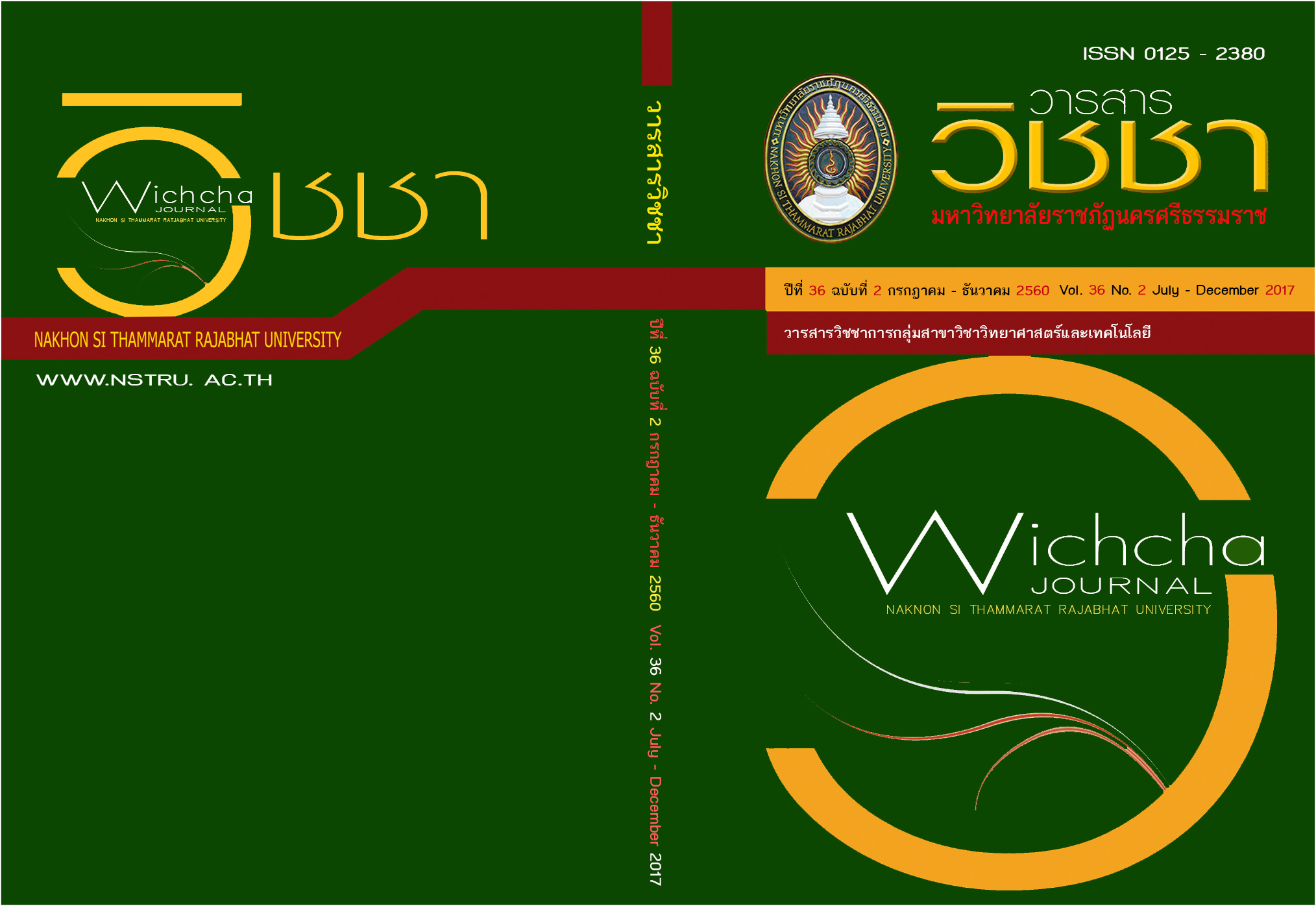การขยายพันธุ์ข้าวพื้นเมืองพันธุ์กาบดำด้วยเทคนิคการเพาะเลี้ยงเนื้อเยื่อ
Main Article Content
บทคัดย่อ
ในอดีตข้าวกาบดำเป็นพันธุ์ข้าวพื้นเมืองที่นิยมปลูกในอำเภอปากพนัง จังหวัดนครศรีธรรมราช เนื่องจากมีคุณค่าทางโภชนาการสูงและทนทานต่อโรคแมลง แต่ปัจจุบันมีการเปลี่ยนแปลงของสภาพแวดล้อมและเกษตรกรนิยมปลูกข้าวพันธุ์ดีแทนข้าวพันธุ์พื้นเมือง จึงเป็นสาเหตุให้ข้าวพันธุ์พื้นเมืองเกิดการสูญพันธุ์ได้ในอนาคต การศึกษานี้ใช้ชิ้นส่วนเมล็ดมาทำการขยายพันธุ์ด้วยเทคนิคการเพาะเลี้ยงเนื้อเยื่อ โดยนำชิ้นส่วนเมล็ดมาเพาะเลี้ยงบนอาหารสูตร Murashige and Skoog (MS) เติม 2,4-dichlorophenoxy acetic acid (2,4-D) เข้มข้น 0, 1, 2 และ 3 มิลลิกรัมต่อลิตร หลังจากเพาะเลี้ยงเป็นเวลา 1 เดือน พบว่า 2,4-D เข้มข้น 3 มิลลิกรัมต่อลิตร ให้การรอดชีวิตสูงสุด 100 % และชักนำแคลลัสสูงสุด 87±0.51 แคลลัสที่ชักนำได้มีลักษณะร่วน (friable callus) 2,4-D เข้มข้น 1 มิลลิกรัมต่อลิตร ให้แคลลัสชนิดแน่น (compact callus) สำหรับการชักนำยอดและรากให้ผลดีบนอาหารสูตร MS เติม Benzyladenine (BA) เข้มข้น 1 มิลลิกรัมต่อลิตร ร่วมกับ Naphthaleneacetic acid (NAA) เข้มข้น 0.1 มิลลิกรัมต่อลิตร ชักนำยอดสูงสุด 16.78% จำนวนยอดเฉลี่ยสูงสุด 2.40 ยอดต่อชิ้นส่วน และชักนำรากสูงสุด 16.67% ความสูงต้นเฉลี่ยสูงสุด 11.74 เซนติเมตรต่อต้น และจำนวนใบเฉลี่ยสูงสุด 1.13 ใบต่อชิ้นส่วน อย่างไรก็ตามอาหารสูตร MS เติม BA เข้มข้น 1 มิลลิกรัมต่อลิตร ร่วมกับ NAA เข้มข้น 0.5 มิลลิกรัมต่อลิตร ให้จำนวนรากเฉลี่ยสูงสุด 2.51 รากต่อต้น แตกต่างอย่างมีนัยสำคัญทางสถิติ
Article Details
เนื้อหาและข้อมูลในบทความที่ลงตีพิมพ์ในวารสารวิชชา มหาวิทยาลัยราชภัฏนครศรีธรรมราช ถือเป็นข้อคิดเห็นและความรับผิดชอบของผู้เขียนบทความโดยตรง ซึ่งกองบรรณาธิการวารสารไม่จำเป็นต้องเห็นด้วยหรือร่วมรับผิดชอบใด ๆ
บทความ ข้อมูล เนื้อหา รูปภาพ ฯลฯ ที่ได้รับการตีพิมพ์ในวารสารวิชชา มหาวิทยาลัยราชภัฏนครศรีธรรมราช ถือเป็นลิขสิทธ์ของวารสารวิชชา มหาวิทยาลัยราชภัฏนครศรีธรรมราช หากบุคคลหรือหน่วยงานใดต้องการนำข้อมูลทั้งหมดหรือส่วนหนึ่งส่วนใดไปเผยแพร่ต่อหรือเพื่อการกระทำการใด ๆ จะต้องได้รับอนุญาตเป็นลายลักษณ์อักษรจากวารสารวิชชา มหาวิทยาลัยราชภัฏนครศรีธรรมราชก่อนเท่านั้น
The content and information in the article published in Wichcha journal Nakhon Si Thammarat Rajabhat University, It is the opinion and responsibility of the author of the article. The editorial journals do not need to agree. Or share any responsibility.
เอกสารอ้างอิง
พีรเดช ทองอําไพ. (2537). ฮอรโมนพืชและสารสังเคราะห : แนวทางการใชประโยชนในประเทศไทย. กรุงเทพมหานคร: หจก.ไดนามิกสการพิมพ.
ภพเก้า พุทธรักษ์ และ วารุต อยู่คง. (2554). ผลของ TDZ และ 2,4-D ต่อการชักนำให้เกิดแคลลัสและยอดของใบอ่อนพุดจีบ. วารสารวิชาการเกษตร 29(2) : 161-169.
รักบ้านเกิด. (2560). การคัดพันธุ์ข้าวหยุมหนุน. [ออนไลน์] เข้าถึงได้จากhttp://www.rakbankerd.com/agriculture/ page.php?id=8147&s=สืบค้นเมื่อวันที่ 3 พฤศจิกายน 2560.
รังสฤษฏ์ กาวีต๊ะ, (2541). การเพาะเลี้ยงเนื้อเยื่อ: หลักการและเทคนิค. พิมพ์ครั้งที่ 3. กรุงเทพมหานคร : มหาวิทยาลยเกษตรศาสตร์.
ศูนย์วิจัยข้าวนครศรีธรรมราช. (2553). ข้าวพื้นเมืองพันธุ์กาบดำ. ศูนย์วิจัยข้าวนครศรีธรรมราช ตำบลบางจาก อำเภอเมือง จังหวัดนครศรีธรรมราช.
อรัญญา ตันติปัญจพร. (2534). กายวิภาคและสัณฐานวิทยาของข้าว (Oryza sativa L.) จากการเลี้ยงเนื้อเยื่อ. วารสารศูนย์เครื่องมือวิจัยวิทยาศาสตร์และเทคโนโลยี. 1(3): 201-204.
อรุณี ยูโซ๊ะ. (2557). การขยายพันธุ์ข้าวหอมกระดังงาโดยเทคนิคการเพาะเลี้ยงเนื้อเยื่อ และการอนุรักษ์พันธุกรรมในหลอดทดลอง. วิทยานิพนธ์วิทยาศาสตรมหาบัณฑิต คณะทรัพยากรธรรมชาติ มหาวิทยาลัยสงขลานครินทร์ วิทยาเขตหาดใหญ่.
Htwe, N. N., M. H. Maziah, C. Ling, F.Q. Zaman, and A.M. Zain. (2011). Responses of some selected Malaysian rice genotypes to callus induction under in vitro salt stress. African J. of Biotech. 10(3): 350-362
Hopkins, G.W. (1999). Introduction to plant physiology. Town: John Wiley & Sons Ltd.
Libin, A., King, P.J.H., Ong, K.H., Chubo, J. K. and Sipen, P.(2012). Callus induction and plant regeneration of Sarawak rice (Oryza sativa L.) variety Biris. African Journal of Agricultural Research 7:4260-4265.
Michiba, K., T. Okamoto, and M. Mii. (2001). Increasing ploidy level in cell suspension cultures of Doritaenopsis by exogenous application of 2, 4-dichlorophenoxyacetic acid. Physiology Planta. 112(): 142-148.
Rattana, K., P. Theerakulpisut, and S. Bunnag. (2012). The effect of plant growth regulators and organic supplements on callus induction and plant regeneration in rice (Oryza sativa L.). Asian J. of Plant Sci. 11(): 182-189.
Revathi and Arumugam. (2011). In vitro callus induction in rice Oryza sativa L. Plant Biology 1: 13-15.
Silva, F, C. J. Stevens, A. Weisskopf, C. Castillo, L. Qin, A. Bevan and D. Q. Fuller. (2015). Modelling the geographical origin of rice cultivation in Asia using the rice archaeological database. PLoS One. 9: 100-104.
Sahrawat, A.K., and S. Chand. (2001). High frequency plant regeneration from coleoptile tissue of indica rice (Oryza sativa L.). In vitro: Cell Dev Biol. 37: 55-61.
Taiz, L. and E. Zeiger. (2002). Plant Physiology. California: The Benjamin/Cummings Publishing Company Inc.


